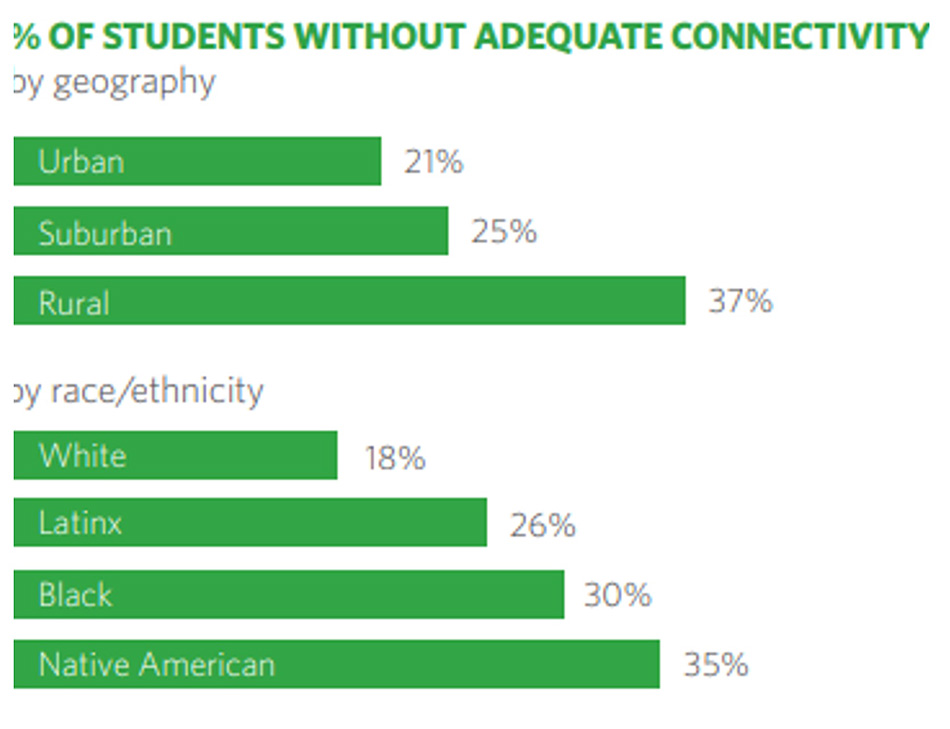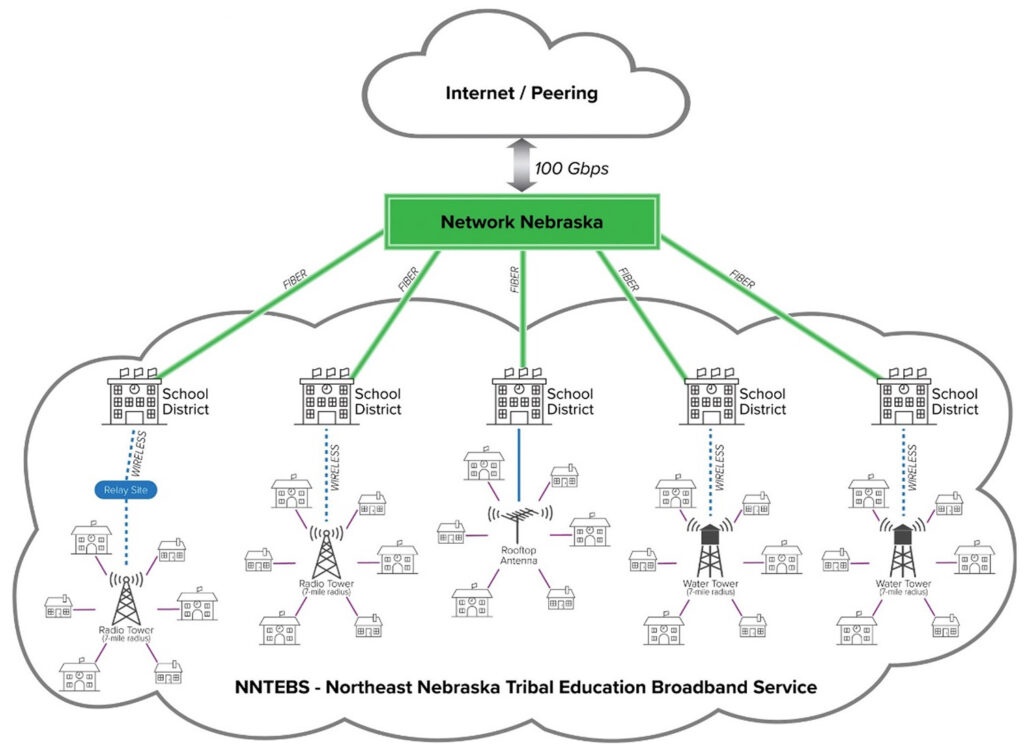Native Americans Set to Cross the Digital Divide

In today’s world, connectivity is the lifeline of education; yet a significant number of American students are being left behind. Based on new research conducted in 2021, researchers at Broadband Now estimate that at least 42 million Americans lack access to terrestrial broadband internet.[i] When you add those without access to reliable and fast internet— defined by the FCC as >25 Mbps download speeds and >3 Mbps upload speeds—the number balloons to as many as 162 million[ii].
Among the communities most adversely affected by the digital divide are Native Americans, many of whom live in rural and low-income communities. Historically, tribes in remote, sparsely populated areas have struggled to attract internet service providers. During COVID-19, already deep unemployment spiked, while schools and families lacked the technology or means to make remote education successful.
The results have set the American Indigenous community back even further compared to the rest of the country. According to a report from the National Indian Child Welfare Association, only 72% of Native American students graduate from high school, compared to 86% of all US high school students. Additionally, Native American students are less likely to attend college and complete their degrees.[iii]
Barriers to bringing broadband to tribal lands
A major challenge to bridging this digital divide is that the Native Indian and Native Alaskan populations consist of about 9.2 million people and 574 federally recognized tribes/entities.[iv] As a result, they lack the size, cohesiveness and influence to attract the needed attention and dollars.
The location of tribal lands is also a significant impediment. Most Native Indian and Native Alaskan lands are located on rough terrain in rural areas, which increases the cost for service providers to connect the areas cost-efficiently. Additional barriers identified by the Office of Indian Energy and Economic Development[v] include:
- Lack of coordination
- Insufficient data
- Missing building blocks
- Insufficient funding
- Complex permitting
- Low adoption
- Weak connection to economic development
FCC data indicates that 73.3% of rural non-AI/AN areas are covered by at least one terrestrial fixed-broadband provider. However, only 46.6% of rural AI/AN communities have fixed broadband coverage.
Taking charge
In the face of these challenges, many tribal leaders have begun efforts to build their own networks to connect schools, students and communities to reliable high-quality Internet. In 2021, the first three-day Tribal Wireless Bootcamp was organized in California. The event brought together Native Americans from around the country who had experience designing and deploying nontraditional broadband networks. The focus was on teaching a business model in which tribes own their own infrastructure and learn to build, maintain, and troubleshoot their own wireless networks. Each tribe in attendance had received a Federal Communications Commission license to access 2.5 GHz spectrum. Since then, additional bootcamps have been held in an effort to reach more tribal entities.
Meanwhile, individual projects designed to implement some of the ideas espoused by groups like Tribal Wireless Bootcamp have continued to take shape, pointing the way to a more connected future for Native American communities.
The northeast corner of Nebraska is very rural and sparsely populated with a majority of Native American households (57%) and 78% of all primary school students are economically disadvantaged. During COVID, the Nebraska Indian Community College (NICC) partnered with five local school districts to create the Northeast Nebraska Tribal Educational Broadband Services (NNTEBS) project.
The goal was to create a ubiquitous high-speed broadband network that could provide reliable access for the districts’ combined 2,100 students. Less expensive line-of-sight wireless technologies proved to be unscalable due to the large numbers of unserved households and the hilly topography. Therefore, the decision was made to leverage public funds to implement a private LTE wireless network carried over the newly licensed 2.5 GHz (EBS) spectrum for tribal entities.

The design uses a network of private LTE base stations and towers operating in the 2.5 GHz band and covering 580 square miles. Each base station connects to a dedicated high bandwidth internet source at one of the schools via wireless point-to-point link.
The Evolved Packet Core (EPC) handles all incoming call traffic from the student devices. The EPC is initially a cloud-based service; as the project grows, the cloud EPC will eventually be replaced by a more cost-effective LTE EPC.
Each district’s existing fiber-optic circuits as well as those at the NICC base station were upgraded to provide 500—1,000 Mbps capacity. In two locations, fixed base point-to-point wireless transport was needed to reach a water tower or community high point to provide line-of-sight connectivity.
Initial rollout of the project targeted 700 homes in the coverage areas. Each home received a customer-premise equipment (CPE) package that included radios with mid-power and high-power antenna options, as well as 2.5 GHz Mi-Fi hotspots for homes in closer range to a base station.
The NNTEBS project was funded in part by the federal postsecondary Title III, Part A Strengthening Institutions program, the Bureau of Indian Education Fund, an American Indian Higher Education Consortium grant, CARES Act Elementary and Secondary School Emergency Relief funding (ESSER), and local school districts. Subsequent expansion of the network in 2022 was made possible by a grant from the Tribal Broadband Connectivity Program.
Today, supported by Federal grant money and a robust wireless ecosystem, the NTEBS partnership is proving that the digital divide can be bridged. As a result, Native American communities like those in Northeast Nebraska are able to enrich student learning, support much needed healthcare improvements and attract community investment.
Trilogy NextGen: Enabling a More Connected Future
At Trilogy NextGen, we celebrate successful EdTech initiatives such as the one implemented by the NTEBS partnership. We realize how difficult it can be to navigate the financial, technical and community-building challenges. Every day, we work with schools and school districts across the U.S., designing, building and managing high-speed wireless solutions that help bridge the digital divide. With a unique skill set featuring broadband, broadcast and cloud expertise, Trilogy NextGen delivers scalable connectivity solutions customized for any wireless network using private LTE/5G, Wi-Fi and ATSC 3.0 technologies.
Our EdTech offerings are driven by world class connectivity solutions and a rich ecosystem of partners and technology to bring new life to education. We provide end-to-end, customized solutions that include but are not limited to:
- Private LTE/5G Networks: We design, deploy and manage private networks that enable districts to offer internet connectivity to those in need; solving issues related to the digital divide and equity.
- Neutral Host for Public Wireless Connectivity: Our efficient and cost-effective solutions enhance signal strength inside buildings and across campus and provide revenue-generating potential.
- Datacasting: Using our unique and specialized one-to-many, ATSC 3.0-enabled expertise, we provide cost-effective solutions for delivering educational content and remote learning opportunities to all stakeholders in your district.
We also help you find and connect to the right funding sources for your project, including E-rate discounts and the wide array of grant opportunities.
Today’s students live and learn in a data-driven world in which high-speed and reliable connectivity is a lifeline. At Trilogy NextGen, we believe everybody should have access to it. To learn more about how we’re helping schools bridge the digital divide, visit: https://trilogynextgen.com/education/.
[i] BroadbandNow Estimates Availability for all 50 States; Confirms that More than 42 Million Americans Do Not Have Access to Broadband; BroadbandNow, report; May 5, 2021
[ii] Who’s Not Online in America Today?; Pew Trusts, research report; May 9, 2020
[iii] What Is The State Of Native American Education?; The Advocate, article; May 11, 2023
[iv] American Indians and Alaska Natives: Key Demographics and Characteristics; National Council on Aging, article; Jan 10, 2023
[v] Expanding Broadband Access; Bureau of Indian Affairs, U.S. Department of the Interior, website
